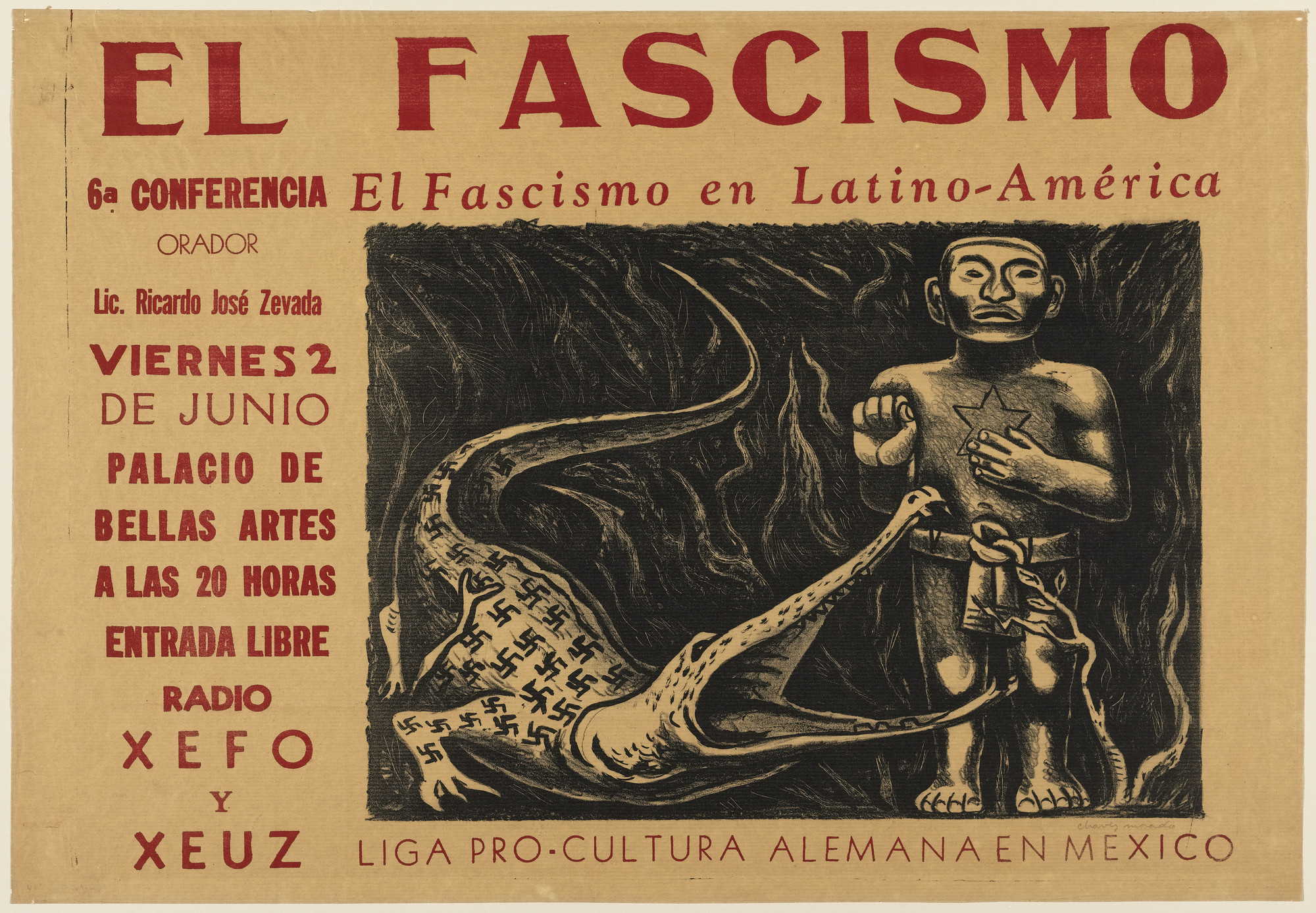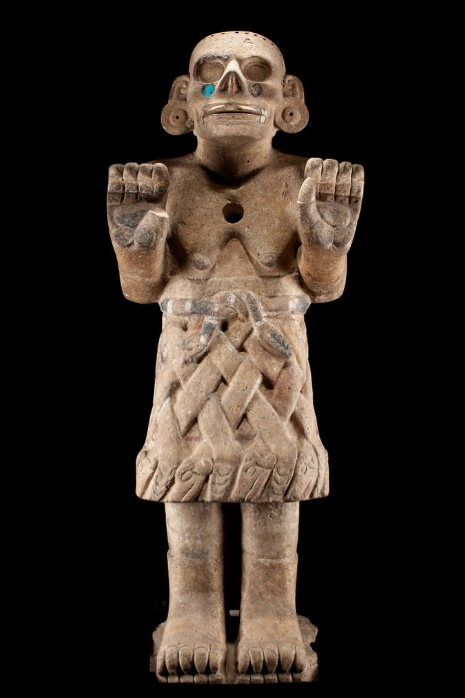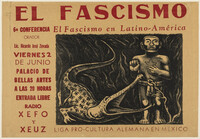On a dirt road, a young boy cocks his hip slightly beneath the weight of a loaded holster that tugs on his small frame and sends ripples through his overalls (Fig. 1). The sleeves of his powder-pink shirt stop short of his dimpled hands, which grip a rifle. Though the barrel’s height rivals his own, the boy looks out with a chilling sense of normalcy, his dark, doe eyes tinged with maturity. The seeming naiveté of his puffed cheeks and playful, homemade cap similarly gives way to his revolutionary armaments and bandolier. From behind, slender hands caress his face, gently cupping his chin and head. A gray-haired woman in a one-shoulder dress towers behind the boy like a monolith of tan skin and white drapery. Her simple gown swoops across her broad torso, tucked beneath the flaccid triangle of her left breast. This angularity continues through her thin arms and sunken collarbones, which cast geometric shadows around the blue-green disk at the center of her chest. Above, her face hides behind a skull-like mask, its vacant eyes and gnarled teeth replacing her features. The same anonymity does not apply to the young boy. His identity is openly stated in the painting’s title, Autorretrato con Nana (1948), as that of the artist himself, José Chávez Morado, who renders an intimate, albeit unsettling, family portrait in oil paint.
José Chávez Morado, Autorretrato con Nana (1948)
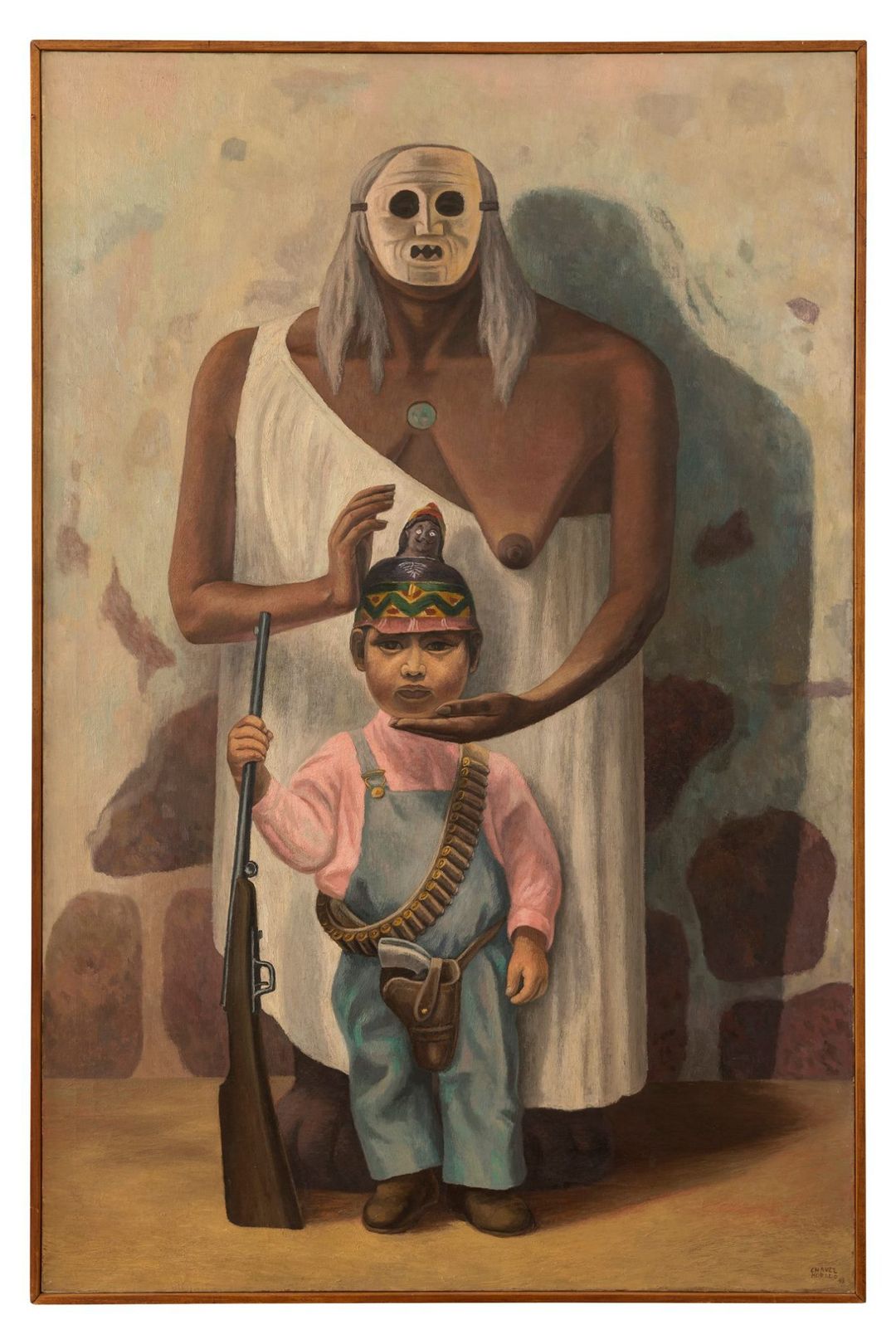
Fig. 1 – José Chávez Morado, Autorretrato con Nana, 1948. Oil on canvas, 163 x 108 cm. Museo de Arte Olga Costa-José Chávez Morado, Guanajuato. Image from Anne Rowe, Carved Narrative: Los Hermanos Chávez Morado (Rancho Mirage: The Annenberg Foundation Trust at Sunnylands, 2017), 65. [Link to source]
Born in Silao, Guanajuato in 1909, near the dawn of the Mexican Revolution, Chávez Morado grew alongside the “fratricidal struggle” of the decade-long civil war.1 In his autobiographical text, “Mis fantasmas” (My Ghosts), Chávez Morado writes of his family's failed efforts to shield him from the bloody conflict: “it would sneak through and reach our sensibility and our eyes… in our minds, the boy [from the school reading assignment] assumed cartridge belts crossed on his chest and a 30-30 in his hand.” Alongside these memories, his paternal family’s leftist political ideology would feature prominently in his oeuvre years later.2 Chávez Morado sketched prolifically from a young age, but he admits that one particular experience cemented his trajectory: his first encounter with postrevolutionary Mexican muralism, which ironically occurred in the United States.3 While working as a temporary farm laborer in California in 1925, sixteen-year-old Chávez Morado visited Pomona College and witnessed José Clemente Orozco’s Prometheus frescos in progress. The artist later described the experience as “a shock that hurt me, made me sick,” and all but ensured his subsequent move to Mexico City.
By 1931, Chávez Morado had become involved in Mexico City’s postrevolutionary arts scene, enrolling in the Escuela Nacional de Bellas Artes.4 Four years later, his studies in engraving, painting, and lithography secured his employment with the Secretaría de Educación Pública, where he began his career as an art educator and muralist in his own right. After becoming a member in the Liga de Escritores y Artistas Revolucionarios (LEAR) in 1937, Chávez Morado’s work took on explicit political affiliations. He began publishing communist-leaning graphics in LEAR’s magazine and the Mexican Communist Party’s newspaper and soon joined the Taller de Gráfica Popular (TGP). Through 1941, Chávez Morado’s politicized contributions to the TGP would be characterized by “rebound” aesthetics, as termed by the artist: “you use [history] as a reference to the present, and that way you could smuggle in criticism.”5 For instance, his antifascist poster from 1939, El fascismo en Latino-América, depicts an Aztec standard-bearer with a Jewish Star of David on his chest, standing steadfast against the threats of a Nazi swastika-covered crocodile (Figs. 2-3). Like his postrevolutionary contemporaries, Chávez Morado had begun deploying, in his words, the “great wealth of symbols in the pre-Hispanic and, in general, in Mexican history,” cementing an “aspiration to turn to their strength, to their gift of permanence.”6 This personal ambition also reflected the selective embrace of Indigenous cultures, past and present, becoming concurrently institutionalized on a national and transnational scale.
Under President Lazaro Cárdenas, a pan-American convention held in Pátzcuaro, Michoacán in 1940 established the Instituto Indigenista Interamericano (III), whose Mexico City offices premiered the first issue of América Indigena, a cultural and social science journal, by the following year.7 As art historian Deborah Dorotinsky argues, the imagery of América Indigena, which included woodcuts by the TGP, would “operate as symbolic capital in the formation of an indigenista visual culture.” Importantly, this symbolic capital relied on a legitimizing visual genealogy of Mexican-ness, as Swiss architect and TGP member Hannes Meyer articulated in his 1949 introduction to El Taller de Gráfica Popular: Doce años de obra artística colectiva.8 According to Meyer, “without the collective spirit of those ancient Indian arts… there could be no TGP,” since the “Indian subconscious emerges in [the members’] best work”—citing the example of José Chávez Morado, “whose acid critique of society is shot through with diabolic fantasy.”9 Ancient Indigenous iconographies thus not only shaped a national indigenist aesthetic but also trickled into the perceived genealogical essence of modern Mexican artists such as Chávez Morado. The validity of this genealogy is central to Autorretrato con Nana, which departs from coeval examples of government-funded works, including those by Chávez Morado (Fig. 4), in issuing an individual claim to an ‘ancient Indian’ inheritance.

Fig. 4 – José Chávez Morado, El retorno de Quetzalcóatl, 1952–53. Mosaic mural, 12 x 4.5 m. Auditorio Alfonso Caso (formerly Auditorio de Ciencias), UNAM, Mexico City. [Link to source]
The efficacy of Chavez Morado’s claim then relies on the uncanny ancestry insinuated in his “Self-Portrait with Granny.” The artist’s “granny,” in fact, straddles the boundary of the mundane and otherworldly, as the greenstone embedded in her chest vivifies her figure with tonalli, a Nahua animating force that “bound together the fates of terrestrial beings and celestial bodies.”10 Beyond this vivifying stone, its inlaid nature testifies to the “legitimized sanctity and authority” of its wearer, as argued by art historian Andrew Finegold.11 The figure’s central inlay, thus, suggests an ancient deification potentially corroborated, however confoundingly, by her classicizing gown. But who exactly does Chávez Morado cast as his grandmother? Aside from her colossal silhouette, Nana’s feet appear clawed and sculpted from the same volcanic mineral as one of the most recognizable Aztec monuments: the Coatlicue (Serpents Their Skirt), excavated from Mexico City’s Zócalo in 1790 (Fig. 5).12 Chávez Morado surely encountered this towering maternal goddess while at the Escuela Nacional de Bellas Artes, since he and his colleagues “went whenever we could to the Museo de Arqueología,” which he recalled as “very influential for my generation.”13 Still, Autorretrato con Nana departs from this renowned Coatlicue, instead citing a more anthropomorphized, Coatlicue-like sculpture from Coxcatlan in the Valley of Tehuacan, Puebla—another statue likely encountered on his museum visits (Fig. 6).
As the representation of a goddess embodier, the Coxcatlan sculpture wears a skeletal face on an otherwise living body and shares the same chest cavity as Nana, whose vivifying inlay is, here, restored with paint.14 Two aspects of Chávez Morado’s figure thereby gain clarity: her stony feet and masked face. Nana’s flesh does not then become basalt below her torso; rather, she appears to wear gritty-textured boots in the shape of jaguar paws, like the Coxcatlan example.15 In place of a skeletal face, Nana dons a contemporary, skull-like mask around her ruffled hair, which recalls the tousled locks once woven into the ancient sculpture’s hairline. This facial substitution also references Mexican folkloric traditions of masking, a recurrent theme in Chávez Morado’s oeuvre (Figs. 7–8). A syncretic masking, or unmasking, features prominently in his ink and gouache Coatlicue (La muerte) (1949) and its oil paint iteration, Coatlicue (n.d.), where the Coxcatlan sculpture splits to reveal a bleeding Jesus Christ in its interior (Figs. 9–10). While the deity embodied by the Coxcatlan figure remains debated,16 Chávez Morado evidently understood the sculpture to represent Coatlicue, per both works’ titles. As her Coxcatlan iteration, Nana thereby assumes the mythological symbolism attributed to Coatlicue at the time of Autorretrato con Nana’s creation.
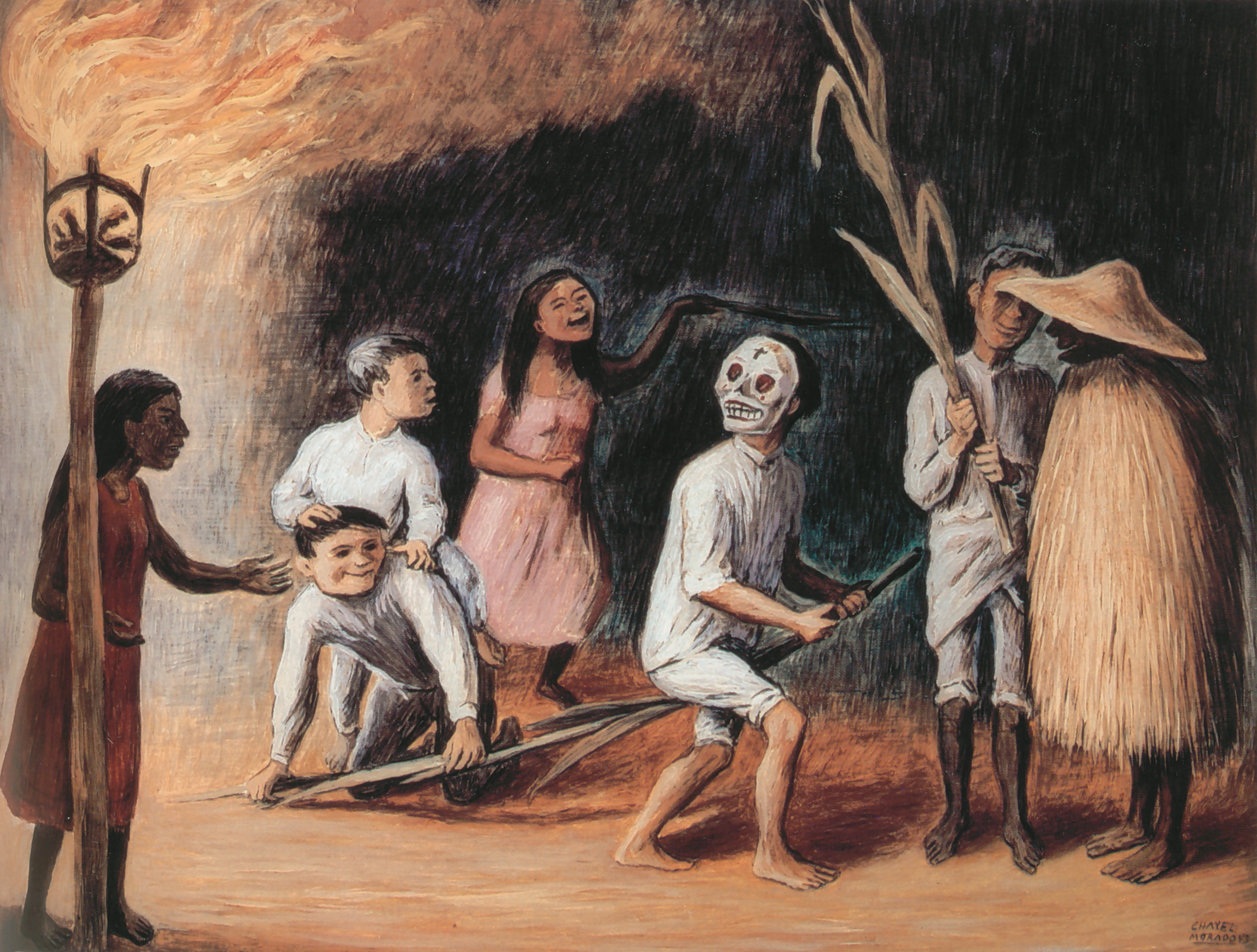
Fig. 7 – José Chávez Morado, Día de muertos, 1943. Oil on masonite, 60 x 44 cm. Collection of Jorge Espinosa Ulloa. Image from José de Santiago Silva, José Chávez Morado: Vida, obra y circunstancias (Mexico City: Ediciones La Rana, 2001), Plate 7.
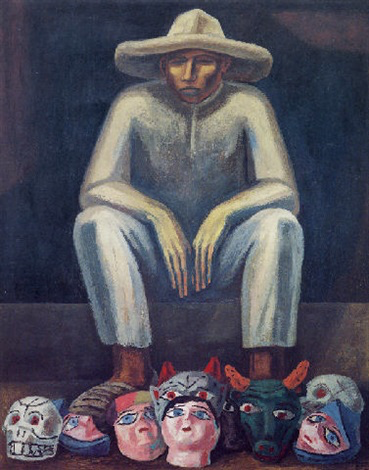
Fig. 8 – José Chávez Morado, Indígena con máscaras, 1955. Oil on canvas, 123 x 97 cm. [Link to source]

Fig. 9 – José Chávez Morado, Coatlicue (La muerte), 1949. Ink and gouache on paper. Museo de Arte Olga Costa—José Chávez Morado, Guanajuato. Image from Ana Isabel Pérez Gavilán, “Chávez Morado, destructor de mitos. Silencios y aniquilaciones de La ciudad (1949),” Anales del Instituto de Investigaciones Estéticas 27, no. 87 (2005): Fig. 13, 105.
In the first half of the twentieth century, two particular sources likely shaped popular perceptions of the Coxcatlan ‘Coatlicue’ and, by extension, informed Chávez Morado’s constructed genealogy: German anthropologist Eduard Seler’s 1901 article "Die Ausgrabungen am Orte des Haupttempels in México" ("Excavations at the Site of the Principal Temple in Mexico"), and the sixteenth-century Florentine Codex (Historia general de las cosas de Nueva España), compiled by Spanish missionary Bernardino de Sahagún and Indigenous collaborators. In his 1901 research, Seler declares that the Coxcatlan figure “can now undoubtedly be described as an earth goddess, and to her the name Couatl icue… can be attributed.”17 Alongside Seler’s characterizations of the goddess—“the great mother who brings forth all life” and “the great abyss that prepares a grave for all living things”—the Florentine Codex further elaborates the divine succession that Chávez Morado adopts. According to the recorded legend, Coatlicue was tending to a temple at Coatepec (Serpent Mountain) when she became pregnant from a ball of feathers.18 Enraged by this, her hundreds of children and eldest daughter, Coyolxauhqui, plotted her death. While still in Coatlicue’s womb, the sun god Huitzilopochtli learned of this plot and so was born fully armed, slaying his siblings in defense of his mother, who is illustrated in the codex with her characteristic serpent skirt (Fig. 11). Autorretrato con Nana’s young Chávez Morado, clad in revolutionary garb, may then personify Nana/Coatlicue’s (modern Mexican) progeny and the state patron god of the Mexica rulers of the Aztec empire, Huitzilopochtli.

Fig. 11 – Coatlicue after giving birth to Huitzilopochtli (above), who then defends her (below). From Bernardino de Sahagún, Historia general de las cosas de Nueva España, 1575–77, Ink on paper, “Book 3: The Origin of the Gods,” Folio 3v. Biblioteca Medicea Laurenziana, Florence. Image from Digital Florentine Codex, Getty Research Institute. [Link to source]
Yet, Chávez Morado’s visualized family tree notably skips a generation. Besides her gray hair, Nana’s bosom conveys a grandmotherly maturity, as her breasts hang flatly against her torso.19 The similarly deflated chest of the Coxcatlan ‘Coatlicue’ testifies to the goddess’ nourishing role, having birthed and fed generations of both gods and humans. Art historian Michael Graulich rhetorically affirms this sustaining characteristic of Coatlicue: “Do they not call her Mother of the Gods (Teteo innan), Our Grandmother (Toci) and Our Revered Mother (Tonantzin)?”20 For Chávez Morado’s self-portrait, the second Nahuatl epithet is particularly relevant. The painting’s titular “Nana” may then refer to Toci, our Nana. While the artist omits a possessive adjective, whether mi (my) or nuestra (our), the title of Autorretrato con Nana renders a semantic ambiguity that becomes communally encompassing via Coatlicue’s plurally possessed moniker of Toci rather than noci (my grandmother).21 Through the reciprocal textual and visual lexicons of the painting, Nana thus symbolically becomes Our (Indigenous Mexican) Grandmother. Rather than simply representing Huitzilopochtli, the young version of Chávez Morado—and by symbolic extension, the modern Mexican nation—then assumes an ancient celestial bloodline as the child of Huitzilopochtli and grandchild of Coatlicue.
Such symbolic claims to a heritage that is not only pre-Hispanic but also divine are further complicated in light of Autorretrato con Nana’s autobiographical genre. While Mexico's government-spurred vogue consisted of using indigenist aesthetics to present and legitimize the nation, Chávez Morado’s self-portrait distinctly co-opts ancient Indigenous references—and their aforementioned ‘strength’ and ‘permanence’—to present and legitimize the self. This painted self-presentation thereby models a social psychological exercise in truth-telling “about oneself both to oneself and to others.”22 In other words, both the viewer and Chávez Morado himself are meant to absorb the mythologized ‘truths’ of the artist’s ancient Mexican ancestry just as organically as they decipher the pre-Hispanic clues of his uncanny family portrait. As the familial approximation to Coatlicue and Huitzilopochtli comes together so then does the image—and by extension, the artist’s self-image. In fact, Chávez Morado evidently intended for this self-presentation to be both strikingly and continually legible, given Autorretrato con Nana’s nearly life-size scale and its permanent place in the Museo de Arte Olga Costa-José Chávez Morado, Guanajuato. The museum’s thirty-four-object “Mano con Mano” collection, curated by the artist couple from their personal collections, includes Autorretrato con Nana—a self-conscious selection that cemented the painting’s place in Chávez Morado’s legacy.23 Then, as now, Autorretrato con Nana thus invited viewers as well as the artist to internalize the Chávez Morado presented in the painting: a young revolutionary of divine, pre-Hispanic genealogy, an inheritor of a monumental Mexican heritage, and an assuredly modern artist.
-----------------------------------------------------------------------------
1. My translation of José Chávez Morado quoted in José de Santiago Silva, José Chávez Morado: Vida, obra y circunstancias (Mexico City: Ediciones La Rana, 2001), 16. This citation also applies to the following sentence.↩
2. José de Santiago Silva, “José Chávez Morado: A Man of Another Age,” Voices of Mexico, no. 56 (Universidad Nacional Autónoma de México, 2001), 31.↩
3. My translation of Chávez Morado quoted in Santiago Silva, José Chávez Morado, 18. This citation also applies to the following two sentences.↩
4. Santiago Silva, “José Chávez Morado,” 32. This citation also applies to the following two sentences.↩
5. My translation of José Chávez Morado quoted in “José Chávez Morado, uno de los grandes pintores y muralistas mexicanos,” Secretaría de Cultura, gob.mx, January 3, 2017. https://www.gob.mx/cultura/prensa/jose-chavez-morado-uno-de-los-grandes-pintores-y-muralistas-mexicanos.↩
6. My translation of Chávez Morado quoted in Secretaría de Cultura, “José Chávez Morado.”↩
7. Deborah Dorotinsky, “América Indígena and Inter-American Visual Indigenismo, 1941–1951,” Latin American and Caribbean Ethnic Studies (2022): 2. This citation also applies to the following sentence.↩
8. Dorotinsky, “América Indígena,” 10.↩
9. Hannes Meyer, “The Workshop for Popular Graphic Art in Mexico: Introduction,” in From Posada to Isotype, from Kollwitz to Catlett: Exchanges of Political Print Culture. Germany – Mexico, 1900–1968, ed. Benjamin H. D. Buchloh and Michaelle N. Harewood (Madrid: Museo Nacional Centro de Arte Reina Sofía, 2022), 243.↩
10. Andrew Finegold, Vital Voids: Cavities and Holes in Mesoamerican Material Culture (Austin: University of Texas Press, 2021), 27, 105.↩
11. Finegold, Vital Voids, 108.↩
12. Elizabeth H. Boone, “The ‘Coatlicues’ at the Templo Mayor,” Ancient Mesoamerica 10, no. 2 (1999), 189, 192.↩
13. My translation of José Chávez Morado quoted in Grisell Villasana Ramos, Chávez Morado en blanco y negro. Los matices de la tinta (Mexico City: Artes de México y del Mundo, S.A. de C.V., 2020), 50.↩
14. Cecelia F. Klein, “Masking Empire: The Material Effects of Masks in Aztec Mexico,” Art History 9, no. 2 (1986): 163.↩
15. Boone, “The ‘Coatlicues’,” 196. This citation also applies to the following sentence.↩
16. See Boone, “The ‘Coatlicues’,” 193-194; Emily Umberger, “Aztec Presence and Material Remains in the Outer Provinces,” in Aztec Imperial Strategies, ed. Frances F. Berdan et al. (Washington, DC: Dumbarton Oaks, 1996), 169-171; Emily Umberger, “Historia del arte e Imperio Azteca: la evidencia de las esculturas,” Revista Española de Antropología Americana 37, no. 2 (2007): 176. As Boone argues, the iconography of the ‘Coatlicue’ excavated in 1790 is shared across various Aztec female supernaturals of fertility/death, including “Coatlicue (Serpents Her Skirt), Cihuacoatl (Woman Serpent), the Cihuapipiltin (Princesses) or Cihuateteo (Goddesses), Itzpapalotl (Obsidian Butterfly), and the Tzitzimime (Demons)” (Boone, 193). More specifically, Umberger argues that the Coxcatlan sculpture represents Cihuacoatl, Coxcatlan’s patron goddess, particularly given its male sculptural counterpart of Xelhua––a mother-son pairing “whose history is parallel to that of the Mexica Huitzilopochtli and his mother Coatlicue” (Umberger, 2007, 176).↩
17. Eduard Seler, "Die Ausgrabungen am Orte des Haupttempels in México," in Gesammelte Abhandlungen zur Amerikanischen Sprach- und Alterthumskunde, v. 2 (Berlin: Asher und Co., 1902), 790. https://archive.org/details/gesammelteabhan00selegoog/page/790/mode/2up. Originally published in the Proceedings of the Anthropological Society of Vienna, Vol. XXXI (1901): 113–37. This citation applies to the following sentence. In light of recent scholarship, Seler’s description of Coatlicue is likely better suited to Tlaltecuhtli (Earth Lord).↩
18. Digital Florentine Codex, ed. Kim N. Richter and Alicia Maria Houtrouw, "Book 3: The Origin of the Gods", Folio 1r–4r, Getty Research Institute, 2023. https://florentinecodex.getty.edu/book/3/folio/4r?spTexts=1&nhTexts=1. This citation also applies to the following sentence.↩
19. Boone, “The ‘Coatlicues’,” 195. This citation also applies to the following sentence.↩
20. My translation of Michel Graulich, “Las grandes estatuas aztecas de Coatlicue y de Yollotlicue,” Estudios de Cultura Náhuatl 60 (2020): 246. This citation also applies to the previous sentence.↩
21. “Teteoinnan” and “citli” in Online Nahuatl Dictionary, ed. Stephanie Wood (Eugene, OR: Wired Humanities Projects, College of Education, University of Oregon, 2000–present). https://nahuatl.wired-humanities.org/content/welcome-online-nahuatl-dictionary.↩
22. W. Ray Crozier and Paul Greenhalgh, “Self-Portraits as Presentations of Self.” Leonardo 21, no. 1 (1988): 30.↩
23. María de Jesús Vázquez Figueroa and Paige Mitchell, “The House,” in Museo de Arte Olga Costa-José Chávez Morado, trans. Harry Porter (Guanajuato: Instituto Estatal de la Cultura, 2014), 52.↩
